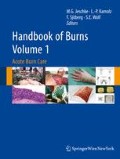Abstract
Clinical practice guidelines (CPG’s) are currently a regular part of a clinician’s armamentarium in virtually all branches of medicine. These guidelines are constantly upgraded and expanded through the work of physicians around the world. GPG’s in burn medicine also play an important role in successful burn treatment. European Burns Association (EBA) and namely its Executive Committee recognize the value of GPG’s, but have identified duplicity and varying levels of quality in the different national and other Practical Guidelines for Burn Care [1–18].
Access this chapter
Tax calculation will be finalised at checkout
Purchases are for personal use only
Preview
Unable to display preview. Download preview PDF.
References
American Burn Association & American College of Surgeons (1995) Guidelines for the operation of Burn Centres. Bull Am Coll Surg 80: 10, 34–41
Childs C (1998) Is there evidence-based practice for burns. Burns 24: 29–33
NSW Health Department (1996) Management guidelines for people with burn injury.
Practice Guidelines for Burn Care (2001) American Burn Association. J Burn Care Rehabil
NSW Health Department (2003) Selected speciality and statewide service plans. Numer 4 Severe Burn Service
National Burn Care Review Committee Report (Ken Dun): Standards and Strategy for Burn Care (year not announced-2002 or 2003)
Allison K, Porter K (2004) Consensus on the pre-hospital approach to burns patient management. Injury 35(8): 734–738
Disaster management and the ABA Plan (2005) ABA Board of Trustees; Committee on Organization and Delivery of Burn Care. J Burn Care Rehabil 26(2):102–106
Küntscher MV, Hartmann B (2006) [Current treatment strategies for paediatric burns]. Handchir Mikrochir Plast Chir 38(3): 156–163. Review. German
Haik J, Ashkenazy O, Sinai S, Tessone A, Barda Y, Winkler E, Orenstein A, Mendes D (2005) Practice Guidelines for burn care, 2006. Burn care standards in Israel: lack of consensus. Burns 31(7): 845–849
Gibran NS (2006) Committee on Organization and Delivery of Burn Care, American Burn Association. J Burn Care Res 27(4): 437–438
American Burn Association and Americal College of Surgeons Committee of Trauma (2007) Guidelines for the Operation of Burn Centers. J Burn Care Res 28(1)
Alsbjörn B, Gilbert P, Hartmann B, Kazmierski M, Monstrey S, Palao R, Roberto MA, Van Trier A, Voinchet V (2007) Guidelines for the management of partialthickness burns in a general hospital or community setting-recommendations of a European working party. Burns 33(2): 155–160
New Zealand Guidelines Group. Management of Burns and Scalds in Primary Care June 2007
Ennis JL, Chung KK, Renz EM, Barillo DJ, Albrecht MC, Jones JA, Blackbourne LH, Cancio LC, Eastridge BJ, Flaherty SF, Dorlac WC, Kelleher KS, Wade CE, Wolf SE, Jenkins DH, Holcomb JB (2008) Joint Theater Trauma System implementation of burn resuscitation guidelines improves outcomes in severely burned military casualties. J Trauma 64[2 Suppl]: S146–51; discussion S151–152
Kamolz LP, Kitzinger HB, Karle B, Frey M (2009) The treatment of hand burns. Burns 35(3): 327–337
Vogt PM, Krettek C (2009) [Standards of medical care for burn injuries]. Unfallchirurg 112(5): 461
Carter JE, Neff LP, Holmes JH 4th (2010) Adherence to burn center referral criteria: are patients appropriately being referred? J Burn Care Res 31(1): 26–30
Author information
Authors and Affiliations
Corresponding author
Editor information
Editors and Affiliations
Rights and permissions
Copyright information
© 2012 Springer-Verlag/Wien
About this chapter
Cite this chapter
Brychta, P. (2012). European practice guidelines for burn care: Minimum level of burn care provision in Europe. In: Jeschke, M.G., Kamolz, LP., Sjöberg, F., Wolf, S.E. (eds) Handbook of Burns. Springer, Vienna. https://doi.org/10.1007/978-3-7091-0348-7_6
Download citation
DOI: https://doi.org/10.1007/978-3-7091-0348-7_6
Publisher Name: Springer, Vienna
Print ISBN: 978-3-7091-0347-0
Online ISBN: 978-3-7091-0348-7
eBook Packages: MedicineMedicine (R0)

